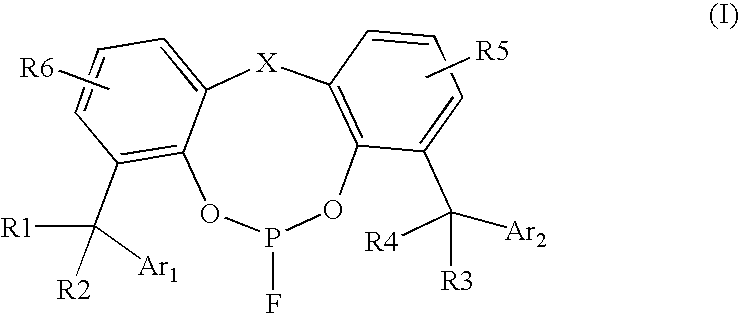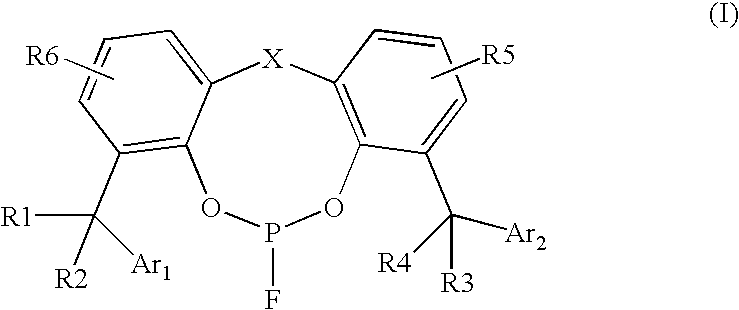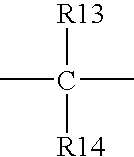Fluorophosphite containing catalysts for hydroformylation processes
a technology of hydroformylation process and fluorophosphite, which is applied in the direction of organic compound/hydride/coordination complex catalyst, physical/chemical process catalyst, organic compound/chemical process catalyst, etc., can solve the problem of worsening of the decomposition of ligands, and achieve enhanced catalyst stability, increased catalyst activity, and improved production rate
- Summary
- Abstract
- Description
- Claims
- Application Information
AI Technical Summary
Benefits of technology
Problems solved by technology
Method used
Image
Examples
examples
Preparation of Ligand A
[0062]Ligand A was synthesized from starting material 2,2′-methylene bis(4,6-di(α,α-dimethylbenzyl)phenol) by following the procedures described in U.S. Pat. No. 4,912,155; the entire content of which is hereby incorporated by reference. Ligand A is very soluble in common organic solvents such as toluene, acetone, cyclohexane, ethyl acetate, etc.
[0063]Spectroscopic Data of Ligand A:
[0064]Ligand A is a new compound and shows a doublet on 31P NMR (in CDCl3) centered at 121.6 ppm (JF-P=1320 Hz). The chemical shift of 19F NMR of Ligand A shows a doublet centered at −64.9 ppm (JP-F=1301 Hz). The chemical shift (in ppm) of 1H NMR of Ligand A in CDCl3 is as follows: 1.42 (s, 6H), 1.58 (s, 6H), 1.67 (s, 12H), 3.28 (d, 1H), 3.90(dd, 1H), 6.96-7.31 (m, 24H).
Preparation of Ligand B
[0065]Ligand B was synthesized from starting material 2,4-di-(α,α-dimethylbenzyl)phenol by following the procedures described in U.S. Pat. No. 4,912,155. Ligand B is slightly less soluble than ...
examples 7-10 (
Ligand A)
[0080]Hydroformylation experiments were carried out in the same manner as Comparative Example 4, except utilizing various amounts of Ligand “A”. The reaction conditions and the results of this work are presented in Table 1.
TABLE 1Effects of Ligand to Rhodium Molar Ratio on Activity and SelectivityExampleTempH2 / COLigand to RhN / ICatalystNos.Ligand(° C.)ratioMolar ratioRatioActivity*C-1C1151:114:11.415.7C-2C1151:130:13.16.6C-3C1151:150:13.83.3C-4B851:115:11.4013.2C-5B851:130:11.857.2C-6B851:160:12.595.0 7A851:115:11.613.0 8A851:130:11.893.23 9A851:160:12.505.4910A851:190:12.726.6711D951:1 5:11.413.7212D951:115:11.949.9813D951:130:12.7215.46*Activity was determined as kilograms of butyraldehydes produced per gram of rhodium per hour. All examples were done using 0.075 mmol of Rh.
[0081]Comparative Examples 1 through 3 illustrate that the hydroformylation reaction activity, under the same reaction temperature and pressure, steadily decreased from 15.7 to 3.3.
[0082]Comparative Exa...
PUM
| Property | Measurement | Unit |
|---|---|---|
| pressure | aaaaa | aaaaa |
| pressure | aaaaa | aaaaa |
| concentration | aaaaa | aaaaa |
Abstract
Description
Claims
Application Information
 Login to View More
Login to View More - R&D
- Intellectual Property
- Life Sciences
- Materials
- Tech Scout
- Unparalleled Data Quality
- Higher Quality Content
- 60% Fewer Hallucinations
Browse by: Latest US Patents, China's latest patents, Technical Efficacy Thesaurus, Application Domain, Technology Topic, Popular Technical Reports.
© 2025 PatSnap. All rights reserved.Legal|Privacy policy|Modern Slavery Act Transparency Statement|Sitemap|About US| Contact US: help@patsnap.com



